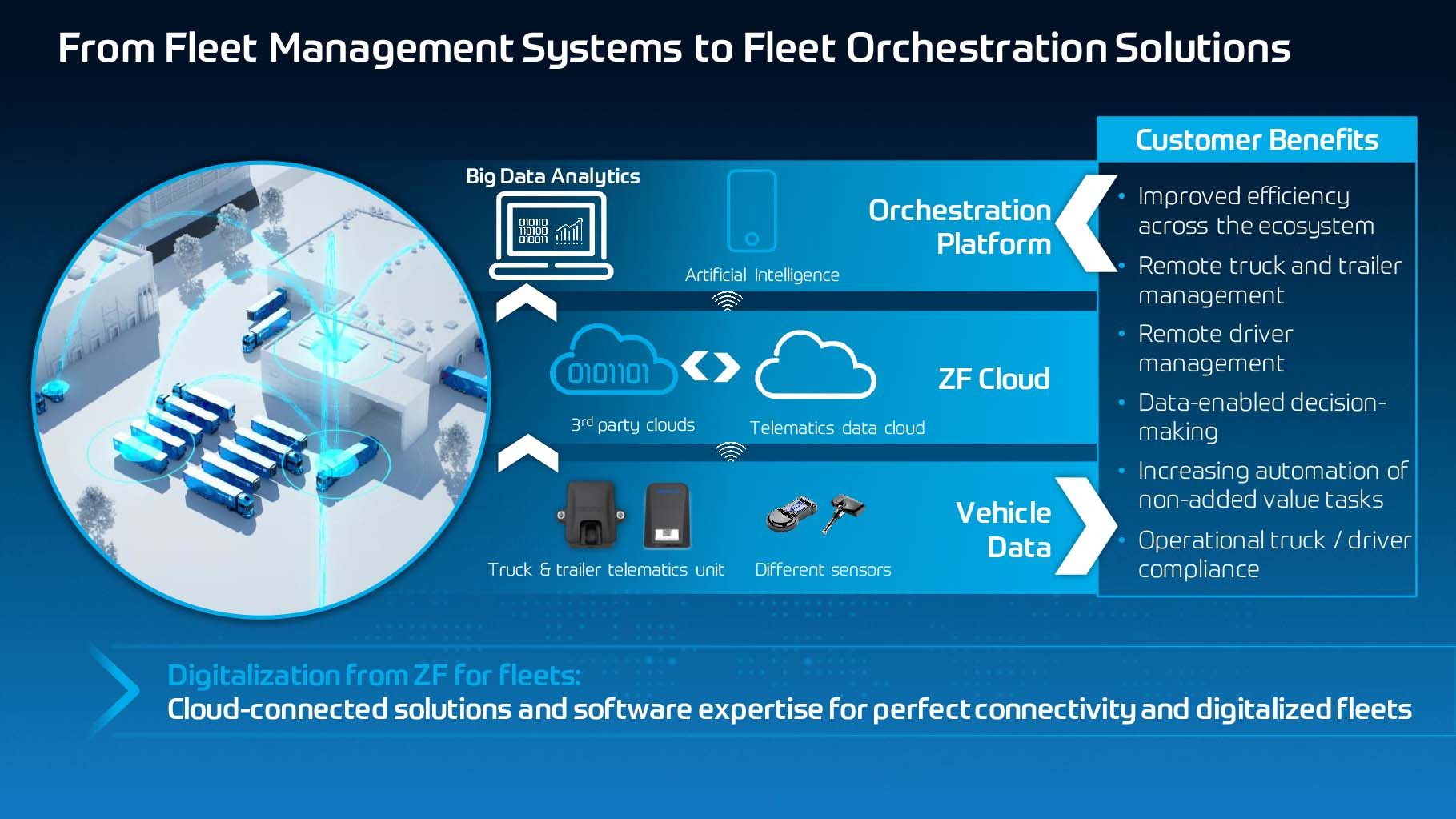Dr Christian Brenneke outline’s clear direction of ZF’s new CVS division
By Jim Gibbins - 18th August 2022

ZF's Electrification portfolio - recent, present and future
Germany - At the ZF Global Technology Day, held at ZF’s Jeverson Test Track in Northern Germany, Dr Christian Brenneke, head of global R&D for the ZF Commercial Vehicle Solutions division outlined the company’s latest systems solutions for the global commercial vehicle industry.
The technology day was held at Jeverson to demonstrate some of the latest technologies for commercial vehicles in the coming months and years. Jeverson is one of three test tracks owned within the group (the others are in Chennai, India and in Rovaniemi, Finland) and is the centre of research for ZF innovations, said Brenneke. Jeverson is where the technologies start as innovations and where the technologies are released once fully certified for the public highway, added Brenneke. Over the years, as Wabco, there has been much investment to make it an advanced research and testing track and centre – the details of which are illustrated in the slide below.
Improvements included reinforced bank curves (1993) to enable heavily loaded trucks to get up to speed; this was followed by a dynamic area to help with compliance to new legislation (2009) and then shortly before Covid (2020) the outer ring was extended to 4.4km to enable autonomous driving testing without bank curves 24 hours and day and seven days a week.

ZF Jeversen R&D centre and test track
CVS was formed on January 1, 2022, by merging the former Wabco company and the ZF CV division.
This merger makes ZF CVS the largest technology and systems supplier in the world, claiming global market leadership in braking and vehicle control technologies, transmissions and shift automation, ECAS systems (levelling control) as well offering a strong portfolio of fleet management and connectivity systems. Brenneke said that a core strength of the Wabco / ZF merger is the company’s ability to integrate systems and technologies and adding value by combining them in an efficient way.
Key to this, continued Brenneke, is its global engineering network, stated Brenneke, comprising more than 4,000 engineers in 59 locations worldwide with the ability to understand local market, customer and engineering needs.
The engineering teams operate in four technology domains:
Vehicle Motion Control – the stability of the vehicle from low to high speeds.
Integrated Safety - everything to do with the safety of the driver and people and traffic around the vehicle.
Automated Driving – on yards and on highways is a key transformation area
Electric Mobility – every associated with electric drivetrains and fuel cell technology.
The enabler for these four areas is its fifth domain of software and digitalization, stated Brenneke, because it is the intelligence of the products and the ability to transfer the information from one product to another in milliseconds that is key to adding value in these four areas.
The portfolio today of the ZF CVS division for trucks, trailer and bus is very broad, stated Brenneke, which is organised into four Systems Solutions of Chassis Technology, Driveline Systems, Driveline Components and Vehicle Dynamics – see Systems Solutions slide below. Brenneke said it is now in the process of bringing technologies from truck and extending these to the trailer, and by enabling and connecting some of the key truck technologies into the trailer we can enable higher performance. Brenneke said:
By increasing their (truck+trailer) connection we will be able to provide ‘Transport as a Service’ in the industry and introduce a charging rate per mile or kilometre into this industry.

ZF Turnkey Systems Solutions for truck, bus and trailer
Technology highlights
Brenneke then went to provide an overview of the main technology highlights the CVS division is introducing and bringing to market in the coming months. The six included:
CeTrax 2 – A central drive electric motor for battery electric or fuel cell vehicles.
eWorks – An electrically powered power-take-off - already available with Daimler’s e-Actros.
SCALAR – A new digital ‘orchestration’ platform which matches people and goods in a very efficient way.
ADOPT – An autonomous driving platform, which is an enabler for yard and highway automation that has a standardised interface to suppliers that bring virtual driver systems for automation by providing vehicle control with an intelligent chassis.
OnGuardMAX – Is the latest in ADAS assistance systems including reversing assist, not only a truck but also a trailer that will comply with new legislation in 2024.
eTrailer – Offers up to 6% fuel saving by adding an electric traction axle on the trailer.

Six new technologies by ZF CVS
Its fleet management software, for example, offers TX-Fuelcompass, a 360 degree view on fuel and refuelling costs (the system gathers data on the truck and trailer from the fleet and combining it with fuel price information, network of pricing and route planning, so the truck driver and the fleet to save cost).
ADOPT is a system designed to deploy full stability control of a truck in unforeseen road conditions like when the road is icy, even with autonomous driving.
The EU driver shortage has accelerated its development of the Advanced Reversing Assist, developed to enable inexperienced drivers to reverse a tractor-trailer or truck-trailer combination safely and without accidents.
Automated Coupling Assist which allows the driver to automatically couple the tractor unit with the semi-trailer (fifth wheel, electrical and air connections) without the driver needing to move from the cab. The logic behind this is to make the driver more efficient.

Many of the innovations at the technology day such as Automated Coupling Assist, Advanced Reversing Assist, the eTrailer electric traction axle are in all in their concept validation stage. Further details of these technologies and their different development stages and when they are likely to be on the market and in series production will be released over the coming weeks at www.truckandbusbuilder.com.
Triple transformation by 2030
Our key challenge at CVS is the rapid arrival of e-mobility, the further focus and need for automation due to the driver shortage and efficiency gain, and the transformation in the architecture, which is going to a higher level of software and on-board computing power.
“So, all three challenges are coming at the same time, with priorities shifting left and right depending on the customer, but there is a huge amount of development effort and a lot of new technologies that need to be brought together all at the same time,” said Brenneke.

Threfold transformation by 2030
Strong growth path focussing on ACE technologies
Brenneke said ZF is already a leader in products in Automation, Connectivity and Electrification (ACE) and plans to remain a leader in these three areas. Today it is focussed strongly on the transformation of its driveline technology from ICE to eMobility (motor, inverter, eAxles, eTrailer, Fuel cell) and it is important to have a broad suite of electric drive products for the truck, bus and trailer industry.

ZF's ACE technology strategy diagram
Electrification - CVS already has a broad electrification portfolio of central drives (CeTrax and CeTrax 2) and wheel-end drives (AVE Axle) with a lot of experience in the bus segment, it is now working on the next generation of electric axles. But beside the electric drives, which remains the main cost element of the vehicles, there are many other components needed for electrification of the whole vehicle.
Without the ICE there is the need for many electrically power components such as an electric air compressor to provide air for brake actuation, air suspension control, power steering and for door operation on buses, etc. Brenneke pointed out the shift from hydraulic to full electric power steering and that electrified power steering also brings an efficiency gain for range of the vehicle. The electric braking system also brings with it a lot of braking efficiency from the recuperation and that by combining the electric drive with the braking system offers an efficiency gain of some 3.5%. There is an increased need for electronic fans for cooling the inverters and other components.
Connectivity & Autonomy - ZF sees strong growth in the need for connection of vehicles, which is driving digitalization and greater efficiency. ZF will continue to introduce more automated systems to raise safety levels and for greater efficiencies by increasing sensors on vehicles to protect other road users, pedestrians as well as the environment. (It introduced automated braking in trucks for pedestrians in China last year).
Advanced technologies likely to offer new business models like TaaS
Brenneke said it has started to introduce automated trucks for yard operations and this technology will be extended to the on-highway road network by the end of the decade.
ZF sees new business models coming into the marketplace such as Transport-as-a-Service. TaaS is a new business model that will come into play as the investment in autonomous trucks increases. More sensors and more computing power on both the truck and trailer will add to the capital cost of the truck and this challenge of the truck has to be solved, said Brenneke; one option might be TaaS.
ADAS and Vehicle safety
ZF is continuously extending its portfolio towards higher levels of automation (Level 4 and Level 5), by often leveraging the technology developed for the passenger car industry. Camera, radar and lidar systems to enable sensing around the vehicle are being developed from passenger car for the high volume truck space, said Brenneke.
ZF now has a broad range of electronics with vastly increased computing power from body controllers up to its high performance ProAI with up 1,000 terra-bytes for faster processing of data in trucks to enable automation.

A complete portfolio of ADAS - Safety systemsTriple technology transformation
Connectivity – FMS and FOS
Fleet Management Systems - ZF is already providing a full set of connectivity devices for the truck but also for the trailer, stated Brenneke. This data is collected in a data cloud, which is an open system and can connect with third party data. Its systems are focussed on an open system designed for collaboration.
Fleet Orchestration Solutions (FOS) - For the front end, ZF has developed its Fleet Orchestration Solutions (FOS) for drivers and fleet operators to management their fleets in a most efficient way. This system constantly tracks the movement of the fleet and its route and payload and optimises the fleet use in real time.

Fleet Management Systems & Fleet Orchestration Solutions



